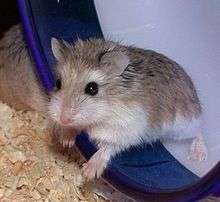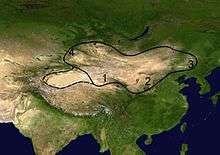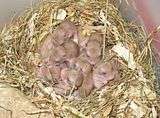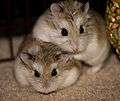Roborovski hamster
| Roborovski hamster | |
|---|---|
 | |
| Scientific classification | |
| Kingdom: | Animalia |
| Phylum: | Chordata |
| Class: | Mammalia |
| Order: | Rodentia |
| Family: | Cricetidae |
| Subfamily: | Cricetinae |
| Genus: | Phodopus |
| Species: | P. roborovskii |
| Binomial name | |
| Phodopus roborovskii (Satunin, 1903) | |
 | |
| Distribution of P. roborovskii | |
Roborovski hamsters (Phodopus roborovskii; formerly Cricetulus bedfordiae) also known as desert hamsters or Robos are the smallest of three species of hamster in the genus Phodopus, averaging under 2 centimetres (0.8 in) at birth and 4.5–5 centimetres (1.8–2.0 in) and 20–25 grams (0.71–0.88 oz) during adulthood.[2] Distinguishing characteristics of the Roborovskis are eyebrow-like white spots and the lack of any dorsal stripe (found on the other members of the Phodopus genus). The average lifespan for the Roborovski hamster is three years, though this is dependent on living conditions (extremes being four years in captivity and two in the wild).[3] Roborovskis are known for their speed and have been said to run an equivalent of four human marathons each night on average.[4]
Distribution and habitat
Roborovski hamsters are found in desert regions, such as the basin of the lake Zaysan in Kazakhstan and regions of Tuva, Mongolia and Xinjiang in China.[5] The hamsters inhabit areas of loose sand and sparse vegetation and are rarely found in areas of dense vegetation and solid clay substrates.[6] They live at elevations of around 1,200 metres (3,900 ft)–1,450 metres (4,760 ft) and although research has been carried out, no fossil record exists for this species.[7][8] Their efficient use of water makes them particularly suited to the steppe and desert regions they inhabit. They dig and live in burrows with steep tunnels as deep as six feet underground. In the wild, Roborovski hamsters are crepuscular, being most active at dawn and dusk.
The Roborovski hamster has been found to be more common in the southern area of its distribution range, in areas such as Yulin, Shaanxi, China. It has been reported as a common sighting by locals in this city and in the sand dunes of the Ordos desert.[9]
Diet
They are omnivorous; they primarily eat grains, vegetables, fruit, and plants, but they will also eat meat and insects in small quantities. Roborovski hamsters remain underground in winter and survive in that season by stockpiling some food in warmer weather and storing it in special food chambers within their burrow system.
The Roborovski hamster mainly feeds on seeds. In Tuva it primarily lives on the seed of the sand alyssum, Nitre Bush, Siberian peashrub, Dracocephalum peregrinum, and milkvetch as well as sedges during the summer-months. Vegetative plant parts are not of significance.[6]
In the Chinese province Shaanxi it is known for foraging millet seeds.[10]
In Mongolia insects like beetle, earwigs and crickets are part of its diet. According to Formosow the stock of several burrows indicate an almost insect-based diet.[11]
Also the consumption of snails has been reported.[12]
In Tuva, the share of animal food is marginal. Flint and Golowkin determined in 1958 and 1959 that nearly 100 percent of the cheek pouches' content consisted of plant food, whereas animal food was only found in 23 percent of the hamsters' pouches at all in 1958 and 32 percent in 1959.[13]
The daily dietary intake of the Roborovski hamsters heavily depends on its body weight. Juveniles have higher intakes of food compared to their weight than adult hamsters. Based on its population structure, Wan et al. calculated an average food intake of ca. two gram plant seeds per day. They specify the functional relation between the daily food intake (N) and the body-weight (M) to be [14]
Pups, juveniles as well as adult hamsters are foraging food in their burrows. [15]
History of human contact
Lt. Vsevolod Roborovski [Russian expeditioner] first made note of these hamsters, discovering them on an expedition in July 1894, though they were not studied scientifically for the best part of another decade, until Konstantin A. Satunin made observations in 1903.[16] The London Zoo imported them into the UK in the 1960s, but the first Roborovski hamsters studied in Britain were imported in the 1970s from Moscow Zoo. (None of them, however, bore offspring.)[17][18] Continental European countries had more success in breeding some Roborovskis, however, and those currently in the UK are descendants of a batch imported from the Netherlands in 1990. They were imported to the USA in 1998,[19] though they are now commonly found in pet shops in several countries. In South Korea, they are almost as common as the winter-white Russian dwarf hamster.
Variation
The Roborovski hamster is distinguished from the Djungarian hamster (Phodopus sungorus) and Campbell's dwarf hamster (Phodopus campbelli) due to its smaller size, sandy coloration of fur and its lack of a dorsal stripe.[20][21] When observed from behind, the neurocranium is rounded and does not appear to be as rectangular as Phodopus campbelli and Phodopus sungorus. The cusps of the lower molars are directly opposite and not alternate, as seen in other members of the genus, and the incisive foramen of the Roborovski hamster is greater than 4 millimetres (0.16 in) in length and is shorter than the length of the upper tooth row, which is uncharacteristic of the other two members of the genus.[20]
Currently, 10 variations of Roborovski hamsters are confirmed.[22][23]
- agouti — a natural grayish-brown with white underside and "eyebrows" (white over eyes)
- "white face" — a dominant mutation producing an agouti-coloured hamster with a white face
- "husky" — a recessive mutation producing a white-faced hamster with a paler, more orangey coat than the agouti colour
- "mottled" or "pied" — both dominant and recessive mutations have been identified, these hamsters have the agouti colouring with irregular patches of white over their heads, bodies and sometimes their faces
- "platinum" — a combination of the dominant white face gene and the husky gene that produces a hamster that looks similar to a white-faced when young, but fades with age to nearly white
- "head spot" — a combination of the dominant and recessive pied genes that creates a pure white animal with one patch of colour on the head
- "white-from-white-faced" or "dark-eared white" — a combination of the dominant white-faced gene and the husky gene that produces a white hamster that retains a greyish undercoat and ears
- "white-from-pied" or "pure white" — a combination of the two pied genes that produces a pure white hamster
- "red-eyed" — a recessive mutation that produces a caramel-coloured hamster with a chocolate undercoat, dark brown (red) eyes, and pale ears
Breeding in captivity has also produced a darker dilution of the naturally sandy-coloured agouti fur. According to Fox (2006) white faced and derived breeds are considered torture-breeding and therefore breeding them is forbidden by law in several European countries like Germany or Austria. The homozygous carrier of the gene variant causes neurological symptoms similar to the whirling disease, where the animal spins itself around until it dies of exhaustion.[24][25]
Breeding
The gender of a Roborovski is determined visually; female openings are very close together and may even look like a single opening, while male openings are further apart. Males usually have a visible scent gland near the navel above the two openings, appearing as a yellow stain.
The breeding season for the Roborovski hamster is between April and September. The gestation period is between 20 and 22 days, producing three to four litters. The litter size is between three and nine, with an average of six.[6]
The offspring weigh 1 gram (0.035 oz)–2.1 grams (0.074 oz) at birth.[26][27] Upon being born, the offspring have no fur, the incisors and claws are visible, but the eyes, pinnae of the ear and digits are all sealed. After a period of three days, the whiskers become visible and after five days, the first dorsal hairs develop. The digits separate after six days and after eleven days, the body is completely formed. The young hamsters open their eyes by day 14 and are able to hear.[26]
|
As pets

Roborovski hamsters, being incredibly fast, agile, and naturally timid or shy, are generally recommended as "look but don't touch" pets. Loud noises can agitate them, and they are extremely skittish. As they rarely bite, Roborovski hamsters may make good pets for owners who enjoy interactive play (in which the hamster explores its owner). This may also provide time for taming them. As light may sometimes disturb them, red lights are recommended to allow an owner to view the hamsters without disturbing them.
Roborovski hamsters are great climbers, like other hamsters. They also like to tunnel and run, so it is vital that their cage has either a flying saucer or wheel. Roborovski hamsters are known to sleep in their wheels, especially in wheels with banked edges. The most suitable and safe tunnels are empty tissue paper rolls. Plastic tunnels are harder to clean, poorly ventilated and therefore prone to breed bacteria and fungi. Paper rolls can simply be thrown away and replaced at nearly no cost. Also the usually transparent tubes do not satisfy the hamster's need for hide-outs and shelter.[28]
Roborovski hamsters seem to be more sociable than other hamster subspecies, especially within family groups, aggression is less likely to occur, but can happen at any time. If that happens, hamsters have to be separated immediately to prevent them from fighting each other to death. Like their wild relatives and nearly all hamsters, Roborovski hamsters prefer a solitary life. [29]
They are also a common dwarf hamster sold at pet stores.[30]
Although claimed to be hypoallergenic, Roborovski hamsters have been associated with the development of asthma in previously asymptomatic owners.[31]
Roborovski hamsters do not particularly take to eating the pellets found in most common retail hamster foods, preferring seeds (including Millet) where possible.[19][32][33]
Based on their natural diet, owners should feed special dwarf hamster food containing mainly small seeds. If not available, budgie food is very suitable, because it contains a lot of millet and other small seeds.[34] Larger and oilier seeds like sunflower seeds should only be given as special treats, since they contain way too much fat compared to their meagre natural food spectrum. You should also offer some animal protein, in form of mealworms or other insects (pet shops or fishing supplies). If you do not like to feed them alive, you can purchase dried insects. Also some hamsters accept fish food like dried gammarus (but not the dried flakes consisting of fish offal)
To support their natural behaviour of foraging and stockpiling, at least parts of the hamsters daily food should be widely spread around its cage, hidden at several spots or wrapped in bathroom tissue - which also makes excellent and safe nesting material, since there is no danger of constricting body parts, like "hamster wool" and it is also completely digestible, because water-soluble, if eaten by accident.
For owners who want to keep the nesting material all natural, in the wildness, the burrows are padded with wool of the Bactrian camel[35] and sheep (if by chance, camel might not be available).[15]
Roborovski hamsters solely live in regions with loose sand. Therefore, you should at least offer your hamster a bowl of sand, for example play sand for kids or even better, chinchilla sand. Bird sand is not suitable, because it contains sharp elements like broken sea shells. Dust bathing will become a vital part of a hamster's daily hygiene and will keep a hamster's coat shiny, because it cleans out the surplus grease of its coat.[36] The sand can be kept clean by sieving or washing out with water only and drying (no soap or other chemicals).
A species-appropriate cage for a Roborovski hamster should at least have a size of 60 cm x 30 cm. [37]
Gallery
Footnotes
- ↑ Shar, S. & Lkhagvasuren, D. (2008). "Phodopus roborovski". IUCN Red List of Threatened Species. Version 2008. International Union for Conservation of Nature. Retrieved 14 July 2009. Database entry includes a brief justification of why this species is of least concern.
- ↑ Carol, Heather. "Roborovski Hamster". Southern Hamster Club. Retrieved 26 April 2013.
- ↑ Chen, Michael. "How Long Do Hamsters Live?". Pet Gear Planet. Retrieved 16 March 2017.
- ↑ Maxwell, Gavin (Director), Hill, Bernard (Narrator) (2008). Wild China (Television production). UK: BBC Natural History.
- ↑ Ma, Y; Wang F; Jin S; Li S. (1987). "Glires (rodents and lagomorphs) of northern Xinjiang and their zoogeographical distribution" (in Chinese). Science Press of Academia Sinica: 274.
- 1 2 3 Flint, Vladimir; Jewgenjewitsch (1966). Die Zwerghamster der paläarktischen Fauna. (in German). vol. 366. Wittenberg/Lutherstadt, Ziemsen. p. 97. Retrieved 28 February 2015.
- ↑ Oldfield, Thomas (April 1908). "The Duke of Bedford's Zoological Exploration in Eastern Asia. - XI. On Mammals from the Provinces of Shan-si and Shen-si, Northern China.". Proceedings of the Zoological Society of London. 78 (4): 963–983. doi:10.1111/j.1469-7998.1908.00963.x. Retrieved 25 January 2014.
- ↑ Topál, GY. (1973). O.G, Dely, ed. "Zur Säugetier-Fauna der Mongolei. Ergebnisse der zoologischen Forschungen von Dr. Z. Kaszab in der Mongolei. Nr. 322" [On the mammalian fauna of Mongolia. Results of the zoological research of Dr. Z. Kaszab in Mongolia. # 322] (PDF). Vertebrata hungarica Musei historico-naturalis hungarici (in German). Népművelési Propaganda Iroda, Budapest. 14: 47–100. ISSN 0506-7839. Retrieved 25 January 2014.
- ↑ Sowerby, Arthur de Clare (1914). Fur and feather in North China. University of California Libraries: Tientsin Press. p. 68. Retrieved 1 March 2015.
- ↑ Allen, 1940; Thomas, 1908. Cited in: Ross, 1994 ("Ecology" p. 3).
- ↑ Alexander Nikolajewitsch Formosow (1929). [The Mammals of northern Mongolia of the Sboram-expedition 1926] Млекопитающие Северной Монголии по сборам экспедиции 1926 г. In: Предварительный отчет Зоологической экспедиции в Северную Монголию. [Preliminary Report of the zoological expedition into northern Mongolia] (in Russian). Sankt Petersburg: publisher of the Sovjet Academy of Science. pp. 1–144. cited in: Ross, 1994 ("Ecology" p. 3).
- ↑ Zdenêk Veselovský; S. Grundová (1964). "Beitrag zur Kenntnis des Dschungar-Hamsters, Phodopus sungorus". 30. Pallas: 305–311. ISSN 0044-3468. cited in: Ross, 1994 ("Ecology" p. 3).
- ↑ Flint und Golowkin, 1961. cited in: Flint, 1966 ("Diet" p. 36).
- ↑ Wan Xin-Rong; Liu Wei; Wang Guang-He; Zhong Wen-Qin (2007). [Food Consumption and Feeding Characters of Phodopus roborovskii on Hunshandake sandy land of Inner Mongolia]. [Chinese Journal of Ecology] (in Chinese). vol. 26. pp. 223–227. ISSN 1000-4890.
- 1 2 Boris Stepanowitsch Judin; Lijana Iwanowa Galkina; Antonina Fedorowna Potapkina (1979). [Mammals of the Altai-Sayan Mountain Region] Млекопитающие Алтае-Саянской горной страны. Nowosibirsk: Nauka. p. 296. cited in: Ross, 1994 ("Ecology" p. 3)
- ↑ DwarfHamsters- Judith Lissenberg p.22-23
- ↑ Konijnen en Knaagdieren Encyclopedie - Esther Verhoeff-Verhallen p.130-131
- ↑ Petwebsite.com
- 1 2 Website specifically about Roborovski hamsters
- 1 2 Argyropulo, A.I (1933). "Die Gattungen und Arten der Hamster (Cricetinae Murray, 1866) der Paläarctic.". Zeitschrift für Säugetierkunde (in German). 20: 129–149.
- ↑ Vorontsov, N.N (1960). "Species of Palaearctic hamsters (Cricetinae, Rodentia) in statu nascendi". Doklady Biological Sciences Sections. 132: 491–493.
- ↑ Oak Farm Roborovskis
- ↑ My New Robos - 'Head Spot' and 'Pure White'
- ↑ Judy Fox (2006). Mein Zwerghamster zu Hause (in German) (4th ed.). Ruhmannsfelden: Bede-Verlag. p. 64. ISBN 3-89860-121-8. p. 11, p. 50
- ↑ Patricia D. Ross (1994). Phodopus roborovskii (PDF). Mammalian Species. pp. 1–4. ISSN 0076-3519.
- 1 2 Flint, WJ; Golovkin, N (1961). "A comparative study of hamster ecology in the Tuva area". Byulletin Moskovskogo Obshchestva Ispytaelei Priody Otdel Biologichskii (in Russian): 57–76.
- ↑ Yudin, BS; Galkina, LI; Potapkina, AF (1979). "Mammals of the Altai-Sayanskoi Gorni district" (in Russian). Nauka: 296.
- ↑ Formosow, 1929. cited in: Flint, 1966 ("Burrows"Image. 38).
- ↑ Sandra Honigs: Zwerghamster. Biologie. Haltung. Zucht. 2. edition. Natur- und Tier-Verlag, Münster 2005, ISBN 3-931587-96-7 (German, 80 pages; p. 14, p. 20).
- ↑ "A Comprehensive Guide to the Roborovski Hamster - Online Hamster Care". Online Hamster Care. Retrieved 2016-02-17.
- ↑ Niitsuma et al., J. Invest. Allergol. Clin. Immunol. 2004; 14(3):221-224
- ↑ Home - Roborovski Hamsters
- ↑ Harry's Guide to Hamsters @ www.petcentreonline.co.uk
- ↑ Flint and Golowkin, 1961. cited in: Flint, 1966 ("Diet" p. 31); Ross, 1994 ("Ecology" p. 3).
- ↑ Flint, 1966 ("Burrows" p. 61, p. 67)
- ↑ Flint, 1966 ("Biotopes" p. 20–21).
- ↑ "Merkblatt für Tierhalter - Zwerghamster (Stand: Febr. 2013)" (in German). Tierärztlichen Vereinigung für Tierschutz e. V. "Tiergerechte Zwerghamsterbehausung" (in German).
Further reading
- Lissenberg, J. Dwerghamsters. Aanschaf, verzorging, Voeding, Fokken Zuidboek Producties: Lisse, The Netherlands: 2002
- Verhoeff-Verhallen, E. Konijnen en Knaagdieren Encyclopedie Rebo Productions: Lisse, The Netherlands: 1997
External links
| Wikispecies has information related to: Phodopus roborovskii |
| Wikimedia Commons has media related to Phodopus roborovskii. |








